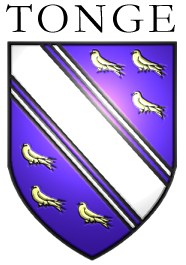
| Home - Back to main page | |
| Index - Full contents list including primary and secondary source documents | |
| Genealogies - Several different Tonge family histories contributed by other researchers | |
| Search Site |
Tonge, Bolton, History of : Extract from "From Affetside to Yarrow", Bolton Place Names & Their History, W. D. Billington 1982, ISBN-0-86360-003-04
TONGE
Although now part of Bolton proper, Tonge was once a Township in the Parish of Bolton, being linked also with Haulgh.
As its name implies it is located on the tongue of land between the River Tonge and Bradshaw Brook just above their confluence. Mills tells us that the name comes from the Old English Tang or twang meaning a fork in a river.
North of their junction, and bounded by the two rivers, lay Tonge Moor owned by the Starkies from the death of Alexander Norris in 1624 until its enclosure in the 19th Century. The Starkie occupation is remembered by the Starkie Arms off Tonge Moor Road. Both the Norris family and the Starkie family lived at Hall i' th' Wood though the latter spent most of their time at their main residence, Huntroyd.
Tonge Moor in earlier times was a very rural area and had on it many folds where handloom weaving was carried on. Notable among these folds were Tonge Fold - later associated with the school of that name - and Tomlin Fold.
The most southerly end of Tonge Moor was chosen as a suitable spot for Bolton's first public cemetery - Tonge Cemetery. Overlooking this cemetery was the Park View Inn made famous by Teddy Ashton (otherwise Allan Clarke) as the Dug and Kennel in his well-known "Tum Fowt Sketches". Baines mentions that on the 29th of May annually Tonge Fold Wakes was held and continued for two or three days. Local folks were encouraged to set up booths and to mix festivity with religious observation. This took place on the banks of the River Tonge.
Apart from the cemetery most of Tonge Moor is now covered by housing, both old cottage property and modern recently erected houses.